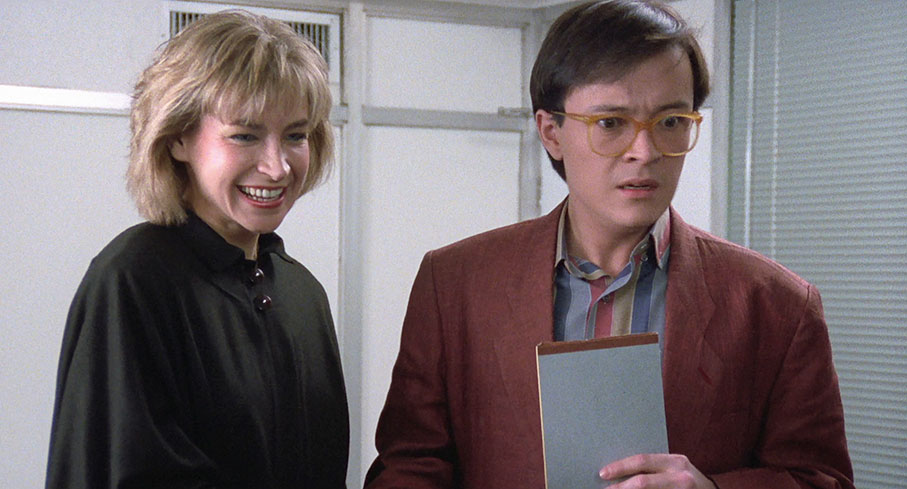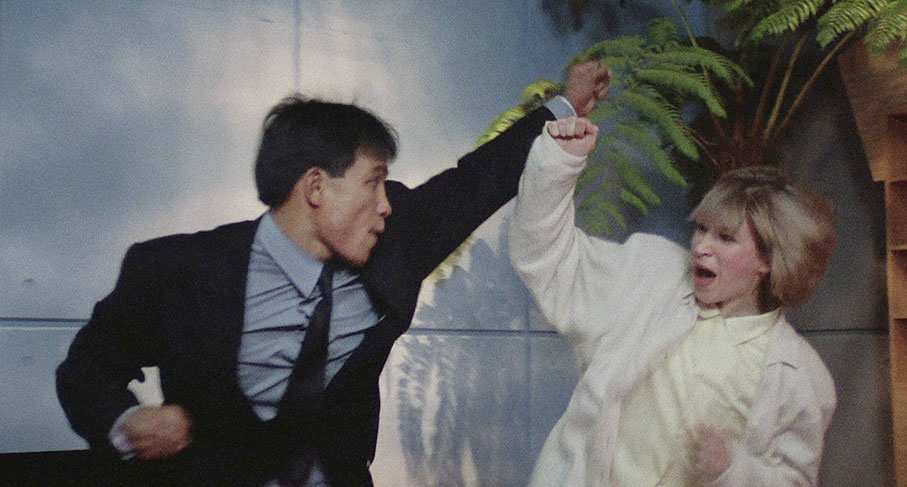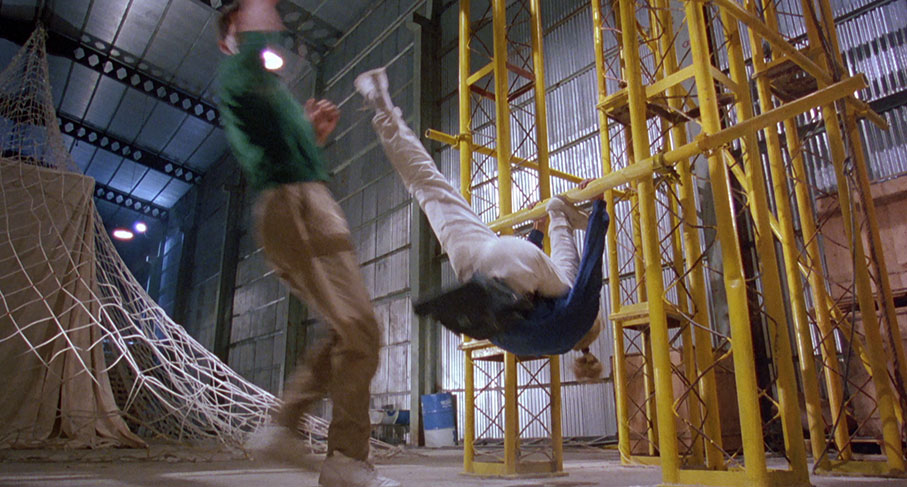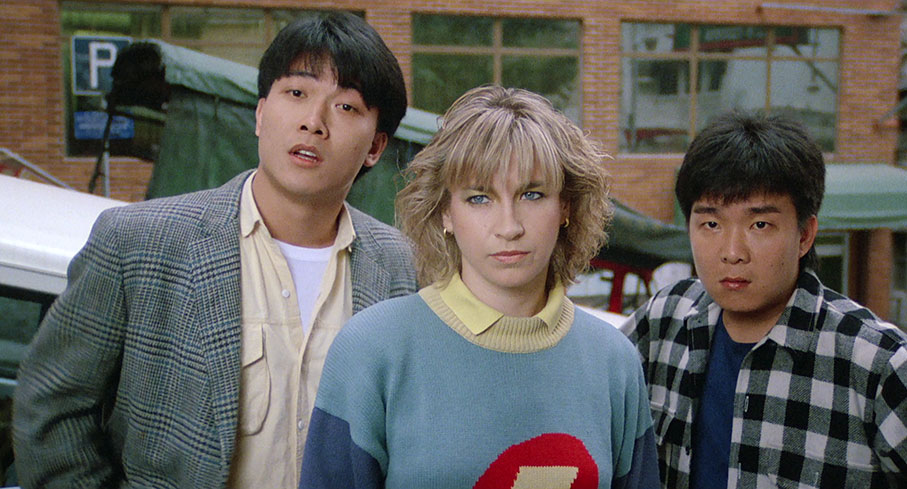| |
"I discussed it with the screenwriter. The story was actually pretty standard. It's your typical plot. The main thing was to see Cynthia Rothrock kick ass." |
| |
Lady Reporter director Mang Hoi |
When it came to the combat in Hong Kong martial arts movies of the 70s and 80s, it was usually the men who took centre stage, and when I say men I mean Chinese men. Female fighters were disappointingly rare (we can thank the kung-fu gods for Angela Mao and Michelle Yeoh), and a non-Chinese lead in these films – which were created with a primarily Chinese audience in mind – was almost unheard of. For several years the Japanese were the go-to bad guys, while Caucasian males were cast either as stuffy colonial officials, or – if the actor had was a martial artist of any skill – as surly and violent hoods for the hero to defeat. The very idea that a white American woman could become an action star in this Asian male world was clearly unthinkable. This didn't deter multi-skilled* American martial artist Cynthia Rothrock, who was hired by Hong Kong's Golden Harvest studio, and in 1985 became the first Caucasian woman to play a joint lead role in a Hong Kong action movie when she co-starred with Michelle Yeoh in Yes, Madam! [Huang jia shi jie].
It's easy to appreciate Rothrock's appeal. She certainly had the looks, but there's also a down-to-earth, girl-next-door aspect to her screen persona, a feature that aligns her with the everyman charm that helped make Jackie Chan such a popular figure in martial arts cinema. And boy, could she fight, and with an energy, athleticism and fluidity that helped to make her an instant star. And Yes, Madam! was a big deal, not just for breaking a firmly entrenched cultural barrier with its Western female co-star, but also because it was a commercial success, launching Rothrock's martial arts movie career and transforming her from unknown outsider to a box-office draw overnight. Several supporting and co-starring roles followed, and in 1989, when actor and fight choreographer Mang Hoi (two roles he performed on the aforementioned Yes, Madam!) got the chance to make his first film as director, the time seemed right to chance casting a non-Chinese actor of Rothrock's popularity and box-office appeal in the title role. Not everything, however, went according to the original plan, but I'll get to that in a minute.

Rothrock plays Cindy, a detective who specialises in investigating Chinese crime in San Francisco, is recruited by the two most woodenly performed CIA men in cinema history to find hard evidence of an international counterfeiting operation that they suspect is operating in the premises of a Hong Kong newspaper, The Asian Post. It helps that Cindy previously lived for some time in Hong Kong, and she even has a close friend there in the shape of pretty Judy (Elizabeth Lee), whose prosecutor father is (Roy Chiao) is currently bringing a case against Wong Tak (Melvin Wong), the nominal publisher of The Asian Post and the man behind the counterfeit cash that is upsetting the economy of American cities. By the time Cindy lands in Hong Kong, an interview has somehow been arranged for the job of reporter at The Asian Post, a post that Cindy lands on nothing more than the cheerful assurance that she'll dig up some scoops. She's teamed with a nervously eager-to-please reporter known as Big Talker (Keith Kwan), who's not exactly enthralled by this prospect. He shows Cindy around the building anyway, handily pointing out the yellow squares on the floor outside one particular room that are there to inform staff that entry is forbidden to everyone except senior management. I wonder what could be behind that door?
Cindy gets her first scoop when a fire breaks out at a local brothel, but after bagging three brilliantly timed photos, she drops her camera whilst pushing through the escaping crowd to rescue to the infant daughter of one of building's occupants. Her leap from an upstairs window is captured on film instead by two reporters from a gutter press rival of The Asian Post, writer Turbo (Tai-Bo) and photographer Shorty (played by director Mang Hoi). No prizes for guessing how Shorty landed his nickname. It's on our first glimpse of the office out of which these two work that the wobbly attempts at humour of the opening scene hit an unexpected home run. When the news comes in that a dismembered female corpse has been discovered, instead of sending a photographer to the scene (too much effort), the only female employee wearily puts down her knitting and throws her arm, leg and head on her desk, where she is splashed with fake blood and quickly photographed in highly deceptive close-up. The assurance from the second commentary on this disc that this is all close to how such low level tabloids operated back in the day only added to my enjoyment of this amusing little montage.
Being a Cynthia Rothrock movie, nobody expects Lady Reporter to be stay true to its title for long, and 17 minutes in the first action goods are delivered when Cindy sneaks into the newspaper office at night to investigate the room to which they are forbidden entry. Before she reaches it she's spotted by the paper's female editor and counterfeit cash operations manager (Margret Miu), and is chased down by a small army of goons under her control. This quickly spills onto the bamboo scaffolding outside the offices in a smart taster for things to come, with Mang really coming into his own in the choreography and constricted location combat of the ensuing fight, which Rothrock and the stunt team perform with impressive gusto, agility, and all-too genuine risk to life and limb. More on that last point in a minute.

To provide further details of the storyline would be a time-consuming and ultimately pointless task, as there are plot holes big enough to fly a military cargo plane through here, and credibility issues beyond even those we've all come to associate with the genre. Martial arts movies are rarely praised for their stories, but things were further complicated here by a decision made by Golden Harvest some months after the cameras had stopped rolling to expand on what they already had and shoot some more scenes. This meant recalling key cast members, but curiously not director Mang Hoi, who was replaced by producer and Yes, Madam! director Corey Yuen. This resulted in some messiness on a range of fronts, adding further confusion to an already busy and now seriously compressed storyline, while key characters disappear from the film without explanation, and the length, style and even colouring of Rothrock's hair change on a scene-by-scene basis, the result of the recall coming midway through the shooting of the China O'Brien films in America. It also means that when the film arrives at what feels like its climax, it still has over half-an-hour to run. All the elements of a climactic scene are certainly there in the shape of a series of blistering fights that pitch Cindy, Shorty, and an undercover cop played by Chin Siu-ho against a smoothly confident bad guy played by Canadian martial artist Billy Chow (who also has a terrific fight earlier against Cindy in her apartment), and a hugely intimidating boss-fight of a villain played by a Thai Muay Thai champion whose name no-one involved in the film can recall. And a performer this skilled and with this sort of screen presence deserves to be remembered, imposing from his self-confidently casual entrance right up to the moment his considerable abilities are undermined by the very thing that should be handicapping Cindy, that she is fighting in a dress and high heels. It seems likely that this repositioning is responsible for the breathlessly choppy first-half plot development, and I can only imagine how much of footage was cut in order to speed up the arrival of what was originally intended to be the finale.
The upside, of course, is that we get two action climaxes for the price of one, and the second is even more visually striking than the first. Set in the warehouse in which Wong is storing his counterfeit cash, it initially pits Cindy against a small army of goons on the sort of steeply angled rope ladder rigging that you used to find on sailing ships, and whose only purpose here appears to be to provide Rothrock and stunt team with a challenging prop on which to do battle. The resulting fight is something to behold, as Rothrock uses both the ropes and the gaps between them to send her assailants flying, even at one point trotting casually down this netting as if out for a casual walk in the countryside, paying no heed to gaps big enough for the smallest misstep to send her tumbling through. And the danger is very real here, as according to Rothrock, a bad fall during the filming of this scene left one unfortunate stuntman paralysed. I'm sorry, but no film is worth that, however spectacular the resulting fight. But the scene doesn't end there, and if casting of a white American female in the lead of a Hong Kong actioner wasn't risky enough, the final fight has her pitted her not against Chinese gangsters, but Vincent Lyn and Jeff Falcon, two highly skilled American martial artists. It's a blistering battle that includes some superbly choreographed and performed restricted-space combat between rows of shipping containers, some neat acrobatics, and even some pole fighting to put Rothrock's weapons expertise to good use.

Narratively speaking, Lady Reporter – a rather condescending and not very kung-fu title for a film in which the female lead wipes the floor with her male opponents – is a bit of a mess, but when the action kicks off, it really delivers. I'd love to see the film that Mang Hoi originally intended and have a strong suspicion that it would make more sense, although this would rob the film of a potential drinking game in which you take a shot every time Rothrock's hair changes its style and/or length. But if you came for the fights – and you surely did, didn't you? – then you're unlikely to feel even remotely short-changed by what Mang, Yuen, Rothrock and the team deliver. I could do without the occasional post-production slowing down of some of the more spectacular moves, the sort that results in stuttering slow-motion instead of the buttery-smooth type that you get when the camera is deliberately over-cranked (we get some of that too, and it's far more effective). Indeed, my conviction that these moves would be even more impressive if played at their regular speed is confirmed by the fact that a couple of them are allowed to do so in the export version of the film (more on that below). I still enjoyed the hell out what was is effectively a collision of two films by two equally talented directors, and on a second viewing even grew rather fond of comic elements that had me wincing just a little the first time around. Hardcore fans of Hong Kong martial arts cinema – and the divine Miss Rothrock in particular – will likely see the film's narrative flaws as part of its charm, and when the fights are this impressively choreographed, performed, shot and edited, I'm not about to argue.
When you pop this Eureka Blu-ray disc into your drive, you're given the option to play either the theatrical version or the export version. At first glance you might think that the only difference would be the dialogue track, with the Cantonese on the theatrical print replaced by an English dub on the export release. But after spotting a couple of small changes in the first scene of the export version and noting that it runs for two minutes longer than the theatrical original, I ran the two side-by-side and quickly realised that the differences went far beyond the spoken language.
I initially tried writing down all of the changes, but this soon proved too large a task for someone whose free time is already limited, as while most – though not all – of the drama scenes play out identically in both versions, the editing in the actions scenes definitely does not. Start any action scene at the same point simultaneously on both versions and they quickly go out of sync. For the most part, the editing on the theatrical cut is faster and tighter, and the export version sometimes includes shots not in the theatrical cut. Curiously, the reverse is sometimes also true. In the theatrical cut, the final fight begins when the two foreign goons land a total of six kicks on Cindy that send her sprawling onto a table, and when she stands up, a further kick from one of the goons lands her on the floor, but in the export version this has all been reduced to a single blow. I suspected a twitchiness on the part of Western censors regarding violence against women to be at the root of this,** but we're talking a martial arts movie where the female character in question is the toughest hombre on the block, so I'm not sure that caution really applies here. A short while later, one of Rothrock coolest moves – a wire-assisted leap where she kicks both thugs in the chest in quick succession in a single fluid move, has also been inexplicably excised from the export version. Why? This time I genuinely have no idea.

My suspicions regarding censorial apprehension a specific type of violence being inflicted on a woman were strengthened during Cindy's fight against the unnamed Muay Thai fighter, a brief piece of which has been lopped from the export version when the Thai grabs Cindy by the back of the neck and attempts to knee her in the face (a grip she breaks free from to perform what may be her coolest move in the film). Earlier in the same fight, however, the export version includes more shots and more blows delivered by both parties that do not appear in the theatrical cut. Elsewhere, the reasons for the differences in editing decisions were completely lost on me, with Cindy's bamboo pole descent from the scaffolding shown in a single wide shot in the export version, but covered more excitingly from three angles the theatrical cut.
The result of new 2K restorations of both the theatrical and export versions, the transfers here are both well up to the high standard set by previous Eureka martial arts film Blu-ray releases. The image is crisp, with a very nicely balanced contrast range that nails the black levels without sucking in shadow detail, while the colour palette has a pleasingly naturalistic feel, with brighter colours really popping without feeling oversaturated. Dust, dirt and damage have been cleaned up, and a fine film grain is visible that occasionally coarsens just a whisper, suggesting a possible shift of film stocks when shooting in interior locations, where the lighting would be more restricted than in the studio or on the street.
The Linear PCM 2.0 mono soundtracks on both prints are in good shape, and while there is some inevitable restrictions in the tonal range, the dialogue, music, and those all-important wooshes and wallops of combat are all clearly rendered. There is no trace of wear or damage on the theatrical track, and while the export track is also clean, in rare moments of silence (just before the pole fight between Rothrock and Falcon is a prime example) a background hiss starts to rise in volume, but this is too brief to be remotely distracting.
As ever with Hong Kong martial arts movies of 70s and 80s, Lady Reporter was filmed without synchronised sound and the voices were dubbed on in post-production, and rarely by the actors that you are seeing on screen. Although the Cantonese dub gives Rothrock a Chinese voice and dialogue that she's clearly not delivering, this is still more authentic and more convincing than the almost comically artificial English dub, where the dialogue is even daffier than the translated Chinese original. That said, those voicing the two CIA agents in the opening scene in the export version are a slight improvement here on their hilariously wooden counterparts on the theatrical cut.
Optional English subtitles kick on by default on the theatrical version. There are no SDH subs on the export version.
Audio Commentary by Frank Djeng & Vincent Lyn on the Theatrical Version
Eureka regular and martial arts movie expert Frank Djeng is here joined by martial artist and actor Vincent Lyn, who plays one of the foreign thugs who go up against Rothrock in the climactic fight and are first introduced when they break up the office of the rival tabloid newspaper. This proves a seriously useful teaming, with Djeng's expertise and research augmented by Lyn's first-hand knowledge of the production, although it quickly becomes clear that he was only on set for the Corey Yuen reshoots. Lyn outlines how he was cast in the film and recalls his first meeting with Cynthia Rothrock, now a close friend with whom he has apparently travelled the world. Djeng, meanwhile, provides details on the actors, the locations, and the production itself, and the two bounce off of each other entertainingly and together are a fountain of useful information and interesting anecdotes.

Audio Commentary by Mike Leeder & Arne Venema on the Export Version
The second Eureka genre dream team of the Hong Kong-based duo of actor, producer and martial arts film expert 'Big Mike' Leeder, and filmmaker and film historian Arne Venema have so much to say about the film that they are barely able to pause for breath. Leeder in particular talks so rapidly and with such enthusiasm that Venema sometimes has to really persist to get a word in edgeways, and even then Leeder will sometimes interrupt him. (He's also become a little too fond on the word "awesome" – sorry, but I've really got a bug up my arse about that one.) This all proves hugely entertaining listening, as the two really know their martial arts movies, and as someone who has performed in a fair few himself, Leeder is on speaking terms with several of the actors and filmmakers under discussion. Leeder describes the film at one point as a "Golden Harvest cut-and-paste movie," and says of the plotting, "If you're watching this movie for the intensity of The Usual Suspects-style twists and turns, you're watching the wrong movie. There's lots of twists and turns, but even Keyser Soze would be confused." Both men provide a mountain of information on the actors and the filmmakers, and have plenty to say about the film itself, including how impressed they are with the fights and the fighters. Leeder shares some fascinating info about Geoff Falcon, who plays the most facially intense of the foreign thugs, and both men remark on how good Cynthia Rothrock still looks today, with Leeder suggesting she has aged like a fine wine, then adding, self-effacingly, "I have not aged like a fine wine. I have aged like a wizened grape. Except I got fatter." How could you not love this guy, just a bit?
The Blonde Fury: Cynthia Rothrock on Making 'Lady Reporter' (16:04)
In this newly filmed interview by Frank Djeng, a most engagingly upbeat Cynthia Rothrock looks back at the making of what was known as either Lady Reporter or Blonde Fury, and does briefly touch on why the title was changed in some regions. She recalls some of the dangers involved in the stunt work, getting injured whilst doing the early window jump, and working with Elizabeth Lee, Billy Chow and Vincent Lyn, whom she reveals was given only a wad of toilet paper to protect his goolies for the shot where she has to kick him in the groin. She also talks about the studio decision to give the film a new climax and bring in Corey Yuen to direct the extra scenes, and how that impacted first-time director (and Yuen's friend) Mang Hoi. A really enjoyable extra.
Director Mang Hoi on 'Lady Reporter' (8:53)
Director Mang Hoi is surprisingly forthright about the making of Lady Reporter, hence the no-nonsense quote that tops this review and his laughter when he says of Rothrock, "Her fighting was most important, right? We're not gonna cast her in a drama!" It doesn't end there, as he then notes that ,"When audiences saw her in action, they would go, 'Wow, this foreign lady can really fight!' And they would buy tickets to see her, whether we made a good movie or not." That said, he does stress the importance of originality in action scenes, and is up front about the sequences shot by Corey Yuen, which he reveals came about because the studio thought the action wasn't 'big' enough. He talks about the uncredited Thai kickboxer, who was new to filming and did not pull his blows when shooting his fight scene with Rothrock, which apparently "scared the shit" out of her. At the very end he also makes some interesting comments about the three different titles by which the film is known, so don't switch off when as soon as the end credits appear. Another very welcome addition.

Selected Scene Commentary with Cynthia Rothrock (17:45)
Cynthia Rothrock joins Frank Djeng to share her memories of the shooting of four of the film's key action scenes: the print room battle that spills out onto the scaffolding outside; the apartment fight with Billy Chow that was shot in a real house rather than a studio set; the brutal clash with the Thai champion whose name no-one can recall; and the entire climactic scene with the rope ladder acrobatics and close-quarter combat in the narrow spaces between shipping containers. Rothrock confirms that the whole film took about five months to shoot, with another month required for the additional scenes, and that she only knew what she was required to do each day when she arrived on set, requiring all of the fight choreography to be learned and quickly rehearsed just before it was shot. It's here that I learned about the stuntman who was paralysed after falling from high up during the rope ladder battle, and Rothrock confirms that the Thai fighter was new to film fighting and thus didn't hold back when delivering what are clearly forceful blows. Another excellent extra.
Trailer #1 (2:33)
A busy Hong Kong trailer for the film under its alternative title of Blonde Fury, where Rothrock is described as "The female Rambo Sylvester Stallone never discovered," complete with a probably unlicenced picture of Stallone to hammer the point home. There's plenty of action, including from the final scenes.
Trailer #2 (3:49)
A trailer compiled for the English-speaking market that consists of almost four minutes of non-stop action, with not a word of dialogue spoken and only a couple of name captions and the title Lady Reporter to remind you what you're watching.
Also included is a 20-page Booklet, the bulk of which consists of an essay titled The Deadliest Cyn by critic, historian and filmmaker James Oliver, which looks in detail at the film's bumpy production and brings together a number of observations made in the disc special features into a single informative piece. Also included are main credits for the film, promotional stills and a poster.
Narratively cluttered but enormous fun, and with a string of blistering combat scenes that really do showcase the skills of everyone involved. Once again, Eureka has done the film proud, with a classy transfer, a pair of typically high quality commentaries, and even contributions from Rothrock herself. For genre fans, most definitely recommended.
|